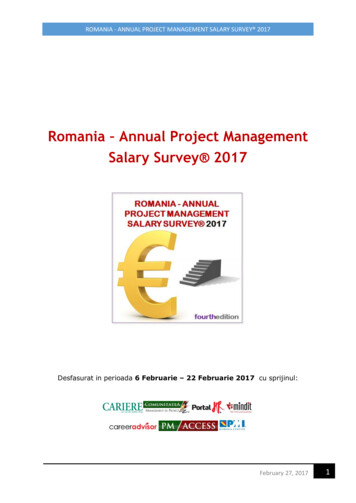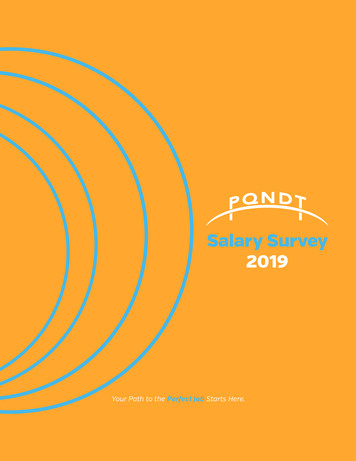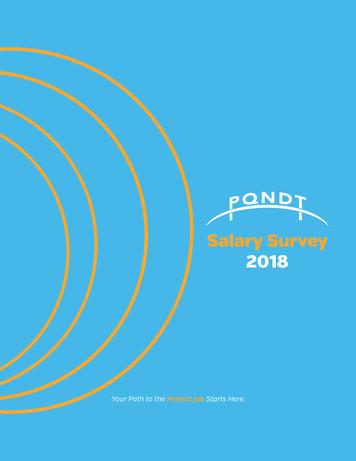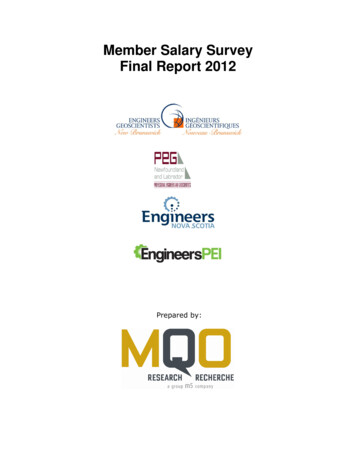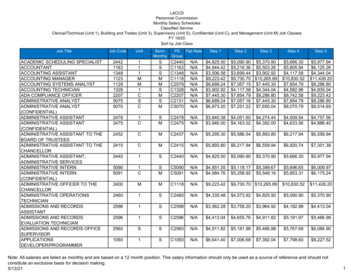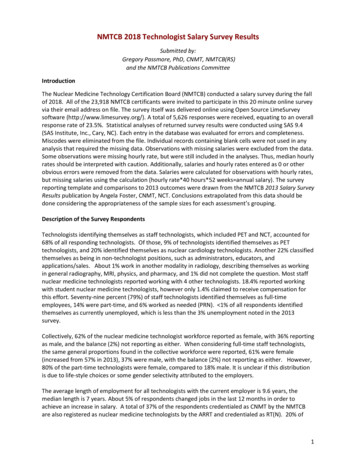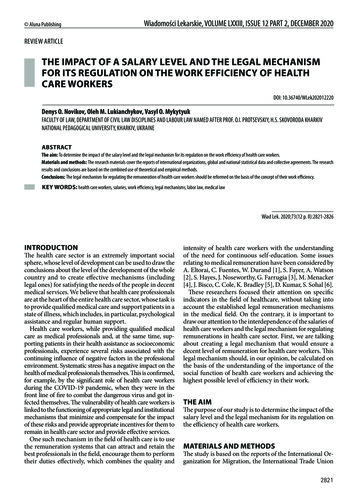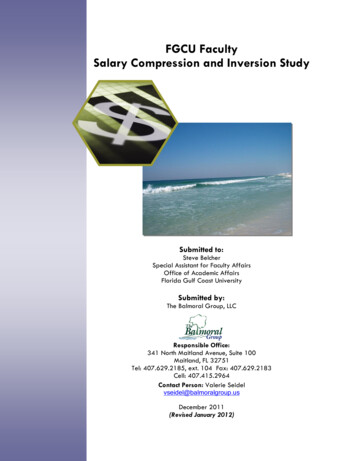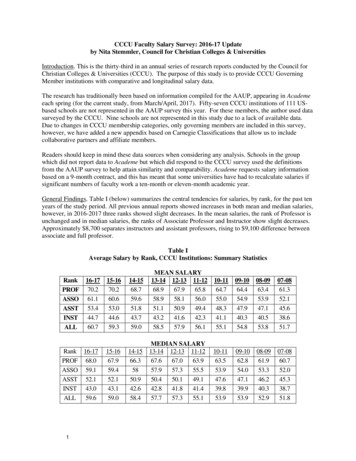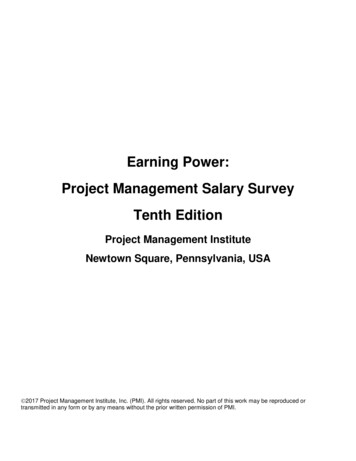
Transcription
Earning Power:Project Management Salary SurveyTenth EditionProject Management InstituteNewtown Square, Pennsylvania, USA 2017 Project Management Institute, Inc. (PMI). All rights reserved. No part of this work may be reproduced ortransmitted in any form or by any means without the prior written permission of PMI.
Earning Power: Project Management Salary Survey—Tenth EditionPublished by:Project Management Institute, Inc.14 Campus BoulevardNewtown Square, Pennsylvania 19073-3299 USA.Phone: 610-356-4600Fax: 610-356-4647Email: customercare@pmi.orgInternet: www.PMI.org 2017 Project Management Institute, Inc. All rights reserved."PMI", the PMI logo, "PMP", the PMP logo, "PMBOK", "PgMP”, “Project Management Journal", "PM Network", and thePMI Today logo are registered marks of Project Management Institute, Inc. The Quarter Globe Design is a trademark ofthe Project Management Institute, Inc. For a comprehensive list of PMI marks, contact the PMI Legal Department.PMI Publications welcomes comments on its publications. Please feel free to send comments to: Book Editor, PMIPublications, 14 Campus Boulevard, Newtown Square, PA 19073-3299 USA.Published in the United States of America. No part of this work may be reproduced or transmitted in any form or by anymeans, electronic, manual, photocopying, recording, or by any information storage and retrieval system, without priorwritten permission of the publisher.
IntroductionAbout PMIProject Management Institute is the world's leading not-for-profit professional membership association for theproject, program and portfolio management profession. Founded in 1969, PMI delivers value for more than 2.9million professionals working in nearly every country in the world through global advocacy, collaboration,education and research. PMI advances careers, improves organizational success and further matures theprofession of project management through its globally recognized standards, certifications, resources, tools,academic research, publications, professional development courses, and networking opportunities. As part of thePMI family, Human Systems International (HSI) provides organizational assessment and benchmarking servicesto leading businesses and government, while ProjectManagement.com and ProjectsAtWork.com create onlineglobal communities that deliver more resources, better tools, larger networks and broader perspectives.About This ReportThe tenth edition of the PMI Earning Power: Project Management Salary Survey builds on features added for theninth edition. The PMI Market Research Department continues to evolve this valuable offering to best serve theglobal project management community. The tenth edition report is based on self-reported salary information frommore than 33,000 project management professionals, bringing accuracy to the salary figures. The stratifiedrandom sampling methodology used for this study results in the ability to report meaningful compensation datafor 37 countries.
Comparison of Number of olombiaCosta RicaEcuadorEgyptFranceGermanyHong sNew ZealandNigeriaPeruPolandQatarSaudi ArabiaSingaporeSouth AfricaSouth KoreaSpainSwedenSwitzerlandTaiwanTurkeyUnited Arab EmiratesUnited KingdomUnited StatesSixth editionSeventh editionEighth editionNinth editionTenth 64146656582671,23848054924135552375910,937
Data ConsiderationsThe validity of data in the report, as in all survey research, is impacted by sample sizes. In some cases, the levelof analysis in this report results in a small sample size. Small sample sizes provide less reliable summarystatistics, such as means and medians, whereas larger sample sizes result in more reliable data. Therefore,salary data are presented in the report only if at least ten individuals provided information for a givenresponse choice. That means that no information (denoted by “--” in the tables) is shown in this report unlessthere are at least ten respondents for a given education level, industry affiliation, company size, etc. Although thenumber ten is an arbitrary number, PMI has used this threshold in previous salary survey reports. Furthermore,requiring such a minimum does ensure respondent anonymity and provides a greater level of reliability in thedata. Sample sizes are reported in all tables by using the symbol “n”. Percentages less than 0.5% are noted bythe symbol “*”.Reporting of Compensation DataAlthough this survey did include questions about alternative compensation methods (such as bonuses), thoseearnings are not included in the “salary” figures. Instead, earnings from other methods are included in the “totalcompensation” figures. Furthermore, only those respondents who reported that they are employed “full-time” areincluded in the salary data.Salary data are presented for the 25th percentile, 50th percentile (median), 75th percentile and mean. Adescription of each follows:25th percentileThe value above which 75% of respondents earned more. For example,if the 25th percentile for annualized salary was 60,000, then 75% ofsurvey respondents earned more than 60,000.50th percentileAlso known as the median. The value at which half of all respondentsearned more and half earned less. For example, if the 50th percentile forannualized salary was 80,000, then 50% of survey respondents earnedmore than 80,000 and 50% earned less than 80,000.75th percentileThe value above which 25% of respondents earned more. For example,if the 75th percentile for annualized salary was 100,000, then 25% ofsurvey respondents earned more than 100,000.MeanAlso known as the arithmetic average. The mean is more susceptible tooutliers (unusually large or small numbers) in the data than the median.
Summary of FindingsGeneral OverviewOver two-thirds of survey participants (70%) report that their total compensation (including salary, bonusand other forms of compensation) increased over the 12 months prior to completing the salary survey.About one-quarter (26%) reported increases of at least 5% over that time period.PMI’s globally-recognized Project Management Professional (PMP) certification provides asignificant advantage when it comes to salary and earning potential in virtually all countriesincluded in this study. Among survey respondents, those holding the PMP certification reporthigher median salaries (23% higher on average across the 37 countries surveyed) than thosewithout a PMP certification.Median salary varied greatly depending on a number of key demographic factors, the greatest of which are thefollowing: Country of employmentNumber of years of experience in project managementPosition/roleAverage size of projects managed, including average project budget and average project teamsizeA more detailed analysis of these factors follows.
Country of EmploymentAs seen in the table below, median salary (when converted to U.S. dollars using normal exchange rates) variesconsiderably among project management professionals from country to country.The countries where project management professionals report the highest median salaries are Switzerland( 130,996 USD), the United States ( 112,000) and Australia ( 108,593 USD) whereas the country with thelowest median salary is Egypt ( 10,159 USD).Annualized Salary (in USD) by CountryCountrySwitzerlandUnited StatesAustraliaGermanyNetherlandsUnited Arab EmiratesNew ZealandQatarUnited KingdomBelgiumIrelandHong KongSwedenCanadaSouth AfricaSingaporeSaudi ArabiaJapanFranceSouth KoreaItalyChileSpainBrazilPolandCosta hinaIndiaNigeriaEgyptn Median salary exchange 3554642414407581,480239178 130,966 112,000 108,593 88,449 86,292 84,930 84,480 82,314 81,227 78,035 75,506 74,160 73,769 73,495 71,802 67,875 63,979 62,930 62,562 62,300 53,933 51,340 48,539 45,114 40,117 38,640 36,244 35,000 34,904 33,130 30,600 30,298 30,015 29,040 25,959 21,498 10,159
Number of Years of Experience in Project ManagementNot surprisingly, median salaries among project management professionals increase along with their tenure inthe profession.Annualized Salary (in USD) by Years of Experience in Project lombiaCosta RicaEcuadorEgyptFranceGermanyHong sNew ZealandNigeriaPeruPolandQatarSaudi ArabiaSingaporeSouth AfricaSouth KoreaSpainSweden 3 years 68,827 32,224 48,747 23,595 16,320 21,000 11,030 44,225 58,247 17,102 50,319 37,753 22,072 17,522 56,090 49,368 19,610 25,229 36,788 55,729 38,103 37,753 51,7513– 5 years 76,474 54,580 33,054 59,996 36,240 22,651 18,700 34,145 22,200 7,280 50,112 69,034 61,800 21,378 61,321 40,989 53,940 23,471 23,521 59,326 61,952 12,505 25,584 30,275 53,120 45,319 45,440 40,688 45,657 38,831 59,9235– 10 years 91,769 64,792 40,602 66,797 50,736 29,040 24,480 38,850 31,200 10,269 56,090 82,247 64,375 24,432 70,112 48,539 56,637 27,082 31,572 75,506 75,328 22,330 36,548 37,844 79,021 63,979 58,587 56,644 56,070 44,575 62,64610– 15 years 111,652 80,899 47,084 76,495 54,360 31,944 37,468 43,200 38,000 12,271 64,719 92,764 79,104 31,304 80,899 53,933 66,526 34,303 36,834 91,685 88,000 28,710 40,325 43,621 98,777 79,974 83,893 75,033 62,300 53,933 73,76915– 20 years 122,358 96,000 58,003 83,432 62,331 34,848 41,480 56,000 14,190 69,217 102,472 92,700 38,175 89,150 59,973 71,920 36,673 49,989 97,079 95,040 38,280 48,366 45,412 109,395 95,436 92,595 87,758 71,200 59,326 76,26520 years 133,830 108,012 64,448 89,994 70,967 26,862 52,025 86,292 103,550 98,494 45,810 103,011 64,719 71,920 50,778 52,812 107,865 98,560 60,914 50,458 126,215 118,362 85,736 95,736 71,200 64,719 85,118SwitzerlandTaiwan 94,698 22,605 101,879 22,953 121,536 29,511 136,003 32,790 146,077 36,069 161,189 47,546TurkeyUnited Arab EmiratesUnited KingdomUnited States 22,086 54,442 41,238 75,000 27,608 65,330 56,234 85,000 33,130 78,396 74,729 100,000 41,412 98,000 82,477 115,000 49,694 124,128 91,224 122,000 143,727 104,971 130,000
PMP Certification StatusThe majority of survey respondents (82%) have the PMP certification. In virtually all countries included in thisstudy, having a PMP appears to offer an advantage in terms of median salary. However, the benefit of havinga PMP varies widely by country. The PMP certification offers the greatest advantage in South Africa wherePMP holders report a median salary that is 58% higher than those who do not hold the certification.PMP tenure also plays a role. Among survey respondents in most countries, median salary steadily increaseswith the length of time one holds a PMP certification.Annualized Salary (in USD) by PMP Certification StatusSouth AfricaEcuadorColombiaChileMexicoIndiaCosta RicaPolandEgyptMalaysiaUnited StatesBrazilUnited Arab EmiratesPeruNew ZealandHong KongSaudi ArabiaSingaporeBelgiumTurkeyUnited KingdomCanadaSpainSouth tzerlandItalySwedenAustraliaJapanNigeriaChinaPMP 55– 1010 Non-PMP PMP Advantage 75,392 39,800 33,308 54,360 36,834 27,486 42,000 41,754 10,754 32,498 115,000 46,080 89,149 36,548 88,704 75,190 69,844 69,304 81,080 33,130 82,477 74,995 50,697 62,300 64,719 90,607 85,607 30,495 86,292 75,506 136,003 53,933 74,903 110,887 62,930 21,542 29,040 66,217 35,000 26,520 51,340 29,230 23,821 39,060 38,146 9,100 28,323 103,000 41,891 80,030 34,112 83,072 64,375 61,420 60,015 70,759 33,130 74,979 68,508 48,539 53,512 59,326 86,292 80,901 27,708 81,977 71,514 128,951 49,618 69,516 100,946 59,334 19,140 26,136 79,780 45,600 39,168 55,266 40,412 30,922 46,200 47,531 13,071 37,576 120,000 48,336 107,795 43,858 91,520 78,795 94,636 78,592 86,292 41,412 87,476 77,995 58,247 66,750 67,955 93,843 98,777 32,462 90,720 80,899 141,040 56,090 77,173 114,711 62,930 26,796 29,040 95,736 54,400 56,119 38,175 49,750 50,963 13,545 45,136 130,000 62,837 115,009 52,538 99,803 105,790 97,984 106,456 101,674 49,694 103,392 88,944 68,603 71,645 75,506 99,011 131,702 36,233 88,719 94,355 151,115 59,919 84,437 122,358 71,920 36,300 47,868 26,000 22,440 37,938 25,836 20,264 31,172 31,662 8,273 25,141 92,000 36,864 72,000 29,848 72,512 61,800 57,581 57,158 66,876 27,608 69,980 63,746 43,146 53,400 55,669 78,202 74,083 26,560 75,506 66,876 121,718 48,539 67,617 100,181 58,435 20,097 1%11%11%8%7%0%
PositionIn virtually all countries included in this study, salary increases with along with added responsibility. Once again,the rate of increase varies extensively from country to country. The most dramatic increase is seen in Nigeriawhere the median salary increases from 13,079 (USD) for a project manager I to 20,735 (USD) for a projectmanager II and 30,305 (USD) for a project manager III.In New Zealand, the median salary for a project manager I increases from 52,800 (USD) to 84,480 (USD) for aproject manager III. In Qatar, the median salary for a project manager I increases from 72,436 (USD) to 114,581 (USD) for a project manager III.Annualized Salary (in USD) by mbiaCosta RicaEcuadorEgyptFranceGermanyHong sNew ZealandNigeriaPeruPolandQatarSaudi ArabiaSingaporeSouth AfricaSouth KoreaSpainSwedenSwitzerlandTai
The tenth edition of the PMI Earning Power: Project Management Salary Survey builds on features added for the ninth edition. The PMI Market Research Department continues to evolve this valuable offering to best serve the global project management community. The tenth edition report is based on self-reported salary information from
